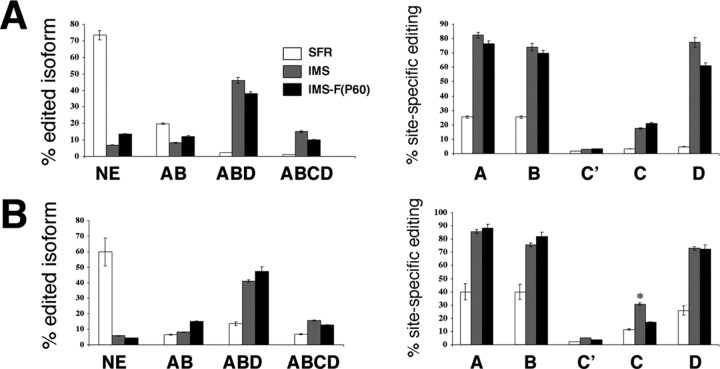Figure 2.
Comparison of basal and FST-induced 5-HT2C pre-mRNA editing between SFR mice, drug-naive IMS mice, and IMS mice treated with fluoxetine between P60 and P88 [IMS-F(P60)]. A, Basal editing phenotype. B, Editing phenotype after exposure to the FST. The percentages of the four major edited isoforms (that, in all animals, represent >70% of all sequences) are shown on the left, and the percentages of site-specific editing (calculated for all sequences) are shown on the right. Data represent means ± SEM of determinations made from 48 sequences per animal and five animals per group (totaling 1440 sequences of 30 animals). A one-way ANOVA (F(14, 60) = 18.41; p < 0.0001) revealed that IMS mice exhibited significantly increased editing at the A, B, C, and D sites (post hoc Tukey–Kramer multiple comparisons test; p < 0.001), decreased expression of nonedited and AB sites-edited 5-HT2C mRNA (p < 0.001 and p < 0.05, respectively), and increased expression of ABD- and ABCD-edited mRNA isoforms (p < 0.01) compared with SFR mice. Measurements obtained after FST exposure (ANOVA; F(9, 55) = 33.6; p < 0.0001) also revealed that IMS-FST mice exhibited significantly higher editing at A, B, C, and D sites [p < 0.001 (A, B, and D sites); p < 0.02 (C site)], lower expression of nonedited mRNA (p < 0.001), and significantly higher expression of ABCD-edited (p < 0.05) and ABD-edited (p < 0.01) mRNA (B) compared with SFR mice. Fluoxetine treatment of IMS mice only led to lower C site editing when compared with IMS controls. *p < 0.05 compared with SFR and IMS-F(P60) mice. NE, Nonedited.

